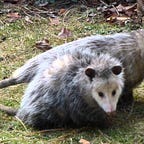Natural Selection: Not The Same For Everyone
In the British Isles, the song of birds, looking to mate, signals the start of spring. European robins, fluting and warbling from sunrise to sunset, eventually pair up and care for their young together. Each breeding season, females lay 5 or 6 eggs in each clutch.
But why such a specific number? Every robin in the Isles produces this same amount of eggs, no more or less. The answer lies in natural selection. Every clutch of eggs must strike a balance between two factors: survival rate and the ability of the parents to care for their young. While more eggs means more birds will reach adulthood, it also means that the parents must provide more food. Robin parents already must make constant trips back and forth from the nest to sustain their rapidly growing chicks. Producing too many eggs risks a chick dying of starvation and therefore wasting the energy needed to produce them. But laying too few eggs decreases the likelihood of any chicks reaching adulthood, and young robins already face a mortality rate of 72% after leaving the nest.
This situation, where natural selection eliminates extreme traits in favor of a middle ground, is known as stabilizing selection. First described in 1945 by evolutionary biologist Ivan Schmalhausen, this concept describes natural selection as it relates to a phenotype, or an observable trait of an organism. Phenotypes result from both genetics and environment, so stabilizing selection does not always describe a genetic change. For example, southern populations of these robins produce smaller clutches, despite no genetic difference. Instead, the environment of southern Europe fluctuates less with the seasons, meaning spring brings less food becomes available with Spring. So, the phenotype of clutch size stabilizes towards a moderate number.
This is not the only example of natural selection as it relates to phenotype. A second form can be found in Manchester, England. Here, the Industrial Revolution changed the trajectory of the peppered moth’s evolution. As the factories of this city polluted the local ecosystem, lichens died, leaving trees barren as dark soot coated everything in its path. This moth, with its white wings coated in light speckles of black, stood out like a sore thumb in its new habitat. So, as its predators ate all of the lightest moths which stood out against their unfamiliar environment, the species became darker. Eventually, the peppered moths around Manchester no longer resembled their more rural counterparts, being entirely coated in black.
These moths experienced directional selection, where one extreme of a trait is favored over the others. This commonly occurs when a species migrates, or their habitat drastically changes through a process like industrialization. Unlike stabilizing selection, which makes populations conform to a middle ground between two phenotypic extremes and stifles diversity, directional selection often increases differences between populations. Loren H. Reisenberg et. al. propose that directional selection is a significant driver of speciation. When two populations become geographically isolated, and must adapt to different environments, directional speciation often drives one group to one extreme while the other changes very little. As many different traits undergo this process, the two groups become different enough that they no longer recognize each other as members of the same species.
Across the globe, on Santa Cruz Island, Darwin’s finches reveal the third form of phenotypic natural selection. Today, there exist many different species with very specialized diets. For example, the small ground finch uses its small, slender beak to feed on small seeds as well as parasites on Galapagos tortoises. Meanwhile, the large ground finch uses its far larger and broader beak to crack open hard nuts. Both of these finches descended from one finch with a generalist beak, which had no specific specialty.
Disruptive selection drove this ancestor finch towards developing both small and large beaks. On an island, where resources are scarce, either extreme gives an advantage as that bird gains a specialization, making it more fit for eating its preferred diet when compared to a bird of a more moderate beak size. This is how disruptive selection works, and how it drives speciation among a single species. In a process known as sympatric speciation, one population can diversify into two over time. This form of selection is the rarest, and its accompanying speciation model is even contested. But lab experiments have consistently supported its existence despite the sparse natural evidence.
Natural selection manifests itself in unique ways depending on the context. The traits selected for may be one extreme, two extremes, or a moderate representation of a phenotype. Understanding the complexity of this process helps us understand how animals diversify, as well as how they homogenize.
